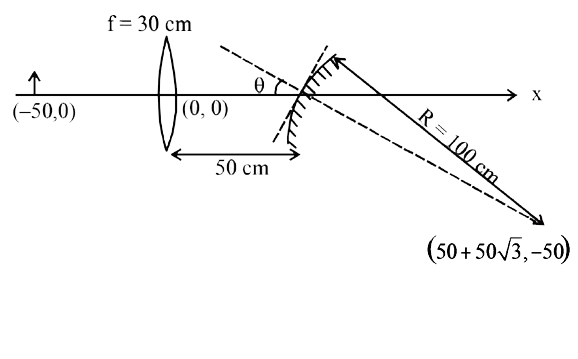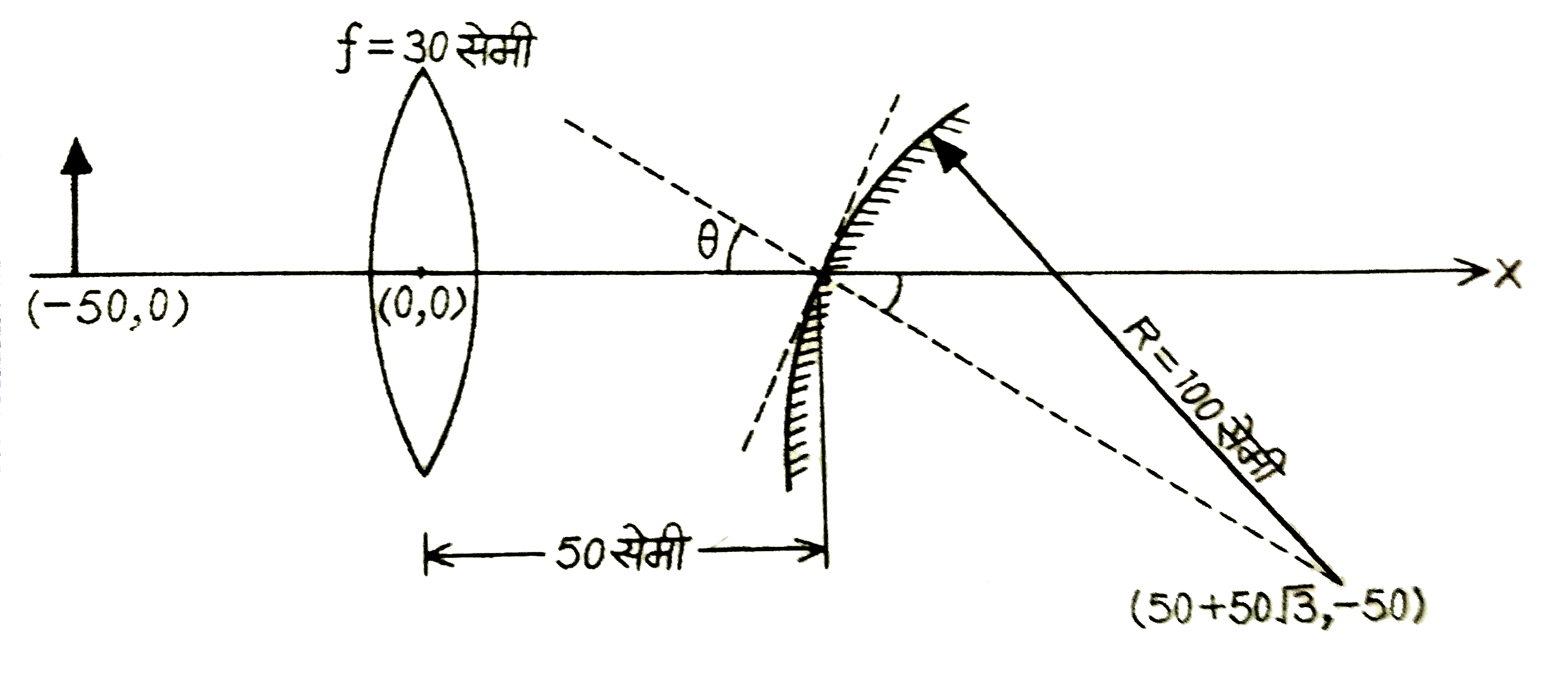A small object is placed 50 cm to the left of a thin convex lens of focal length 30 cm. A convex spherical mirror of radius of curvature 100 cm is placed to the right of the lens at a distance of 50 cm. The mirror is tilted such that the axis of the mirror is at an angle θ=30degree to the axis of the lens, as shown in the figure
If the origin of the coordinate system is taken to be at the centre of the lens, the coordinates (in cm) of the point (x,y) at which the image is formed are
 Solution in Gujrati
Solution in Gujrati
(25,25√3
(1253,25√3)
(50−25√3,25)
(0,0)
The correct Answer is:A
_E01_233_S01.png)
For lens V=(−50)(30)−50+30=75
For mirror V=(25√32)(50)25√32−50=−50√34−√3
m=−vu=h2h1⇒h2=−⎛⎜
⎜⎝−50√34−√325√32⎞⎟
⎟⎠.252
h2=+504−√3
The x coordinate of the images
=50−v cos30+h2cos60≈25
The y coordinate of the images
= vsin30,+h2sin60≈25√3
Topper's Solved these Questions
- GEOMETRICAL OPTICSBOOK - ALLEN CHAPTER - GEOMETRICAL OPTICSEXERCISE - MCQ
5 Videos
- GEOMETRICAL OPTICSBOOK - ALLEN CHAPTER - GEOMETRICAL OPTICSEXERCISE - MATCHING
2 Videos
- GEOMETRICAL OPTICSBOOK - ALLEN CHAPTER - GEOMETRICAL OPTICSEXERCISE - EXERCISE-05 (A)
35 Videos
- CURRENT ELECTRICITYBOOK - ALLEN CHAPTER - CURRENT ELECTRICITYEXERCISE - EX.II
66 Videos
- GRAVITATIONBOOK - ALLEN CHAPTER - GRAVITATIONEXERCISE - EXERCISE 4
9 Videos
Similar Questions
A ray of light travelling in a transparent medium falls on a surface separating the medium from air at an angle of incidence of 45 degree. The ray undergoes total internal reflection. If n is the refractive index of the medium with respect to air, select the possible value (s) of n from the following:
View SolutionAn optical component and an object S placed along its optic axis are given in Column I . The distance between the object and the component can be varied. The properties of images are given in Column II . Match all the properties of images from Column II with appropriate components given in Column I.
_E01_239_Q01.png)
View SolutionIf two mirrors are kept at 60∘ to each other, then the number of images formed by them is ......
View SolutionIn the Bohr's model of hy drogen atom, the electron moves around the nucleus in a circular orbit of radius 5×10−11m. Its time period is 1.5×10−16s. The current associated with the electron motion is:-
View SolutionAssertion : The difference in the value of acceleration due to gravity at pole and equator is proportional to square of angular velocity of earth.
Reason : the value of acceleration due to gravity is minimum at the equator and maximum at the pole.
View SolutionAn optical system consists of a thin convex lens of focal length 30 cm and a plane mirror placed 15 cm behind the lens. An object is placed 15 cm in front of the lens. The distance of the final image from the object is
View SolutionA point object is placed at a distance of 12 cm from a convex lens of focal length 10 cm. On the other side of the lens, a convex mirror is placed at a distance of 10 cm from the lens such that the image formed by the combination coincides with the object itself. The focal length of the convex mirror is
View SolutionA convex lens and a convex mirror of radius of curvature 20cm are placed co-axially with the convex mirror placed at a distance of 30cm from the lens. For a point object at a distance of 25cm from the lens, the final image due to this combination coincides with the object itself. What is the focal length of convex lens ?
View SolutionA convex lens of focal length 15cm is placed in front of a convex mirror. Both are coaxial and the lens is 5cm from the apex of the mirror. When an object is placed on the axis at a distance of 20cm from the lens, its is found that image coincides with the object. Calculate the radius of curvature of mirror.
[55cm]
View SolutionA convex lens of focal length 15 cm is placed on a plane mirror. An object is placed at 30 cm from the lens. The image is
View SolutionA convex lens and a convex mirror are separated by a distance of 10 cm such that the reflecting surface of the mirror faces the lens. The image of an object placed in front of the convex. Lens at a distance of 20 cm is found to coincide with the object. If the focal length of the convex lens is 15 cm, determine the focal length of the mierror.
View Solution15 सेमी फोकस-दूरी वाला एक द्वि-उत्तल लेन्स समतल दर्पण के सामने रखा है | लेन्स तथा दर्पण की बीच दूरी 10 सेमी है | लेन्स से 30 सेमी की दूरी पर एक छोटी वस्तु रखी गयी है | इसका अंतिम प्रतिबिम्ब :
View Solutionएक छोटी वस्तु को 30 सेमी फोकस दुरी वाले एक पतले उत्तल लेन्स की बायीं ओर 50 सेमी की दूरी पर रखा गया है | 100 सेमी की वक्रता त्रिज्या वाले एक उत्तल गोलाकार दर्पण को लेन्स के दायीं ओर 50 सेमी की दूरी पर रखा गया है | दर्पण को इस प्रकार से झुकाया गया है कि दर्पण की अक्ष लेन्स की अक्ष से θ=30∘ का कोण बनती है, जैसा चित्र में दर्शाया गया है

यदि निर्देशांक पद्धति का मूल बिंदु लेन्स के मध्य में हो, तो जहाँ प्रतिबिम्ब बना है उस बिंदु का निर्देशांक (x,y) सेमी में है :
View Solution+4D क्षमता वाले उत्तल लेंस के बायी ओर उससे 30 सेमी की दूरी पर एक बिन्दु वस्तु O रखी है। जब इस लेंस से 50 सेमी की दूरी पर एक उत्तल दर्पण रख दिया जाता है। तो लेंस - दर्पण के इस संयोजन द्वारा बना वस्तु का प्रतिबिंब वस्तु O पर ही बनता है। उत्तल दर्पण की फोकस दूरी ज्ञात कीजिए।
View SolutionA point object O is kept at a distance of 30 cm from a convex lens of power + 4D towards its left. It is observed that when a convex mirror is kept on right side at 50 cm from the lens, the image of object O formed by lens-mirror combination coincides with object itself. Calculate focal length of mirror
View SolutionA concave mirror of focal length 20 cm and a convex lens of focal length 10 cm are kept with their optic axes parallel but separated by 0.5 mm as shown in the figure. The distance between the the lens and mirror in 10 cm. An object of height 3 mm is placed on the optic axis of lens at a distance between the lens and mirror is 10 cm. An object of height 3 mm is placed on the optic axis of lens at a distance 15 cm from the lens. Find the length of the image formed the mirror in mm.
View Solution
